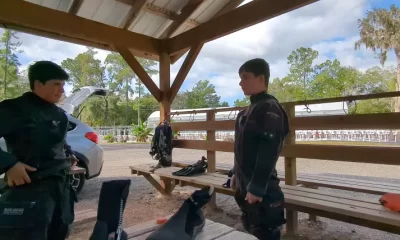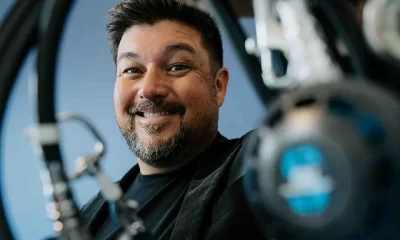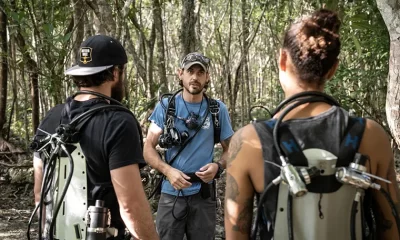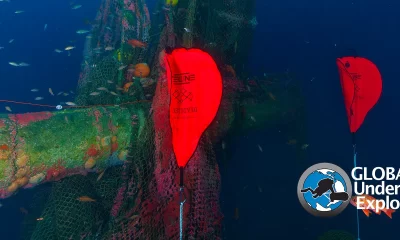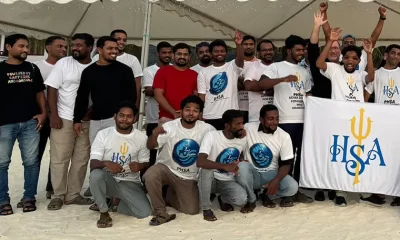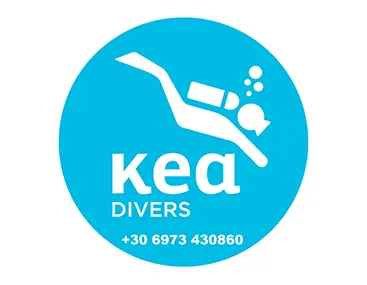Community
Deep Into DEEP WEEK
Aussie GUE tech and cave diver turned freediver Dean Laffan takes us deep into breath-hold culture at one of the premier freediving camps on the planet. Welcome to DEEP WEEK! Are you ready to stretch, meditate, do yoga, hold your breath, go underwater and dive as deep as you can go? Take a deep breath and click here.
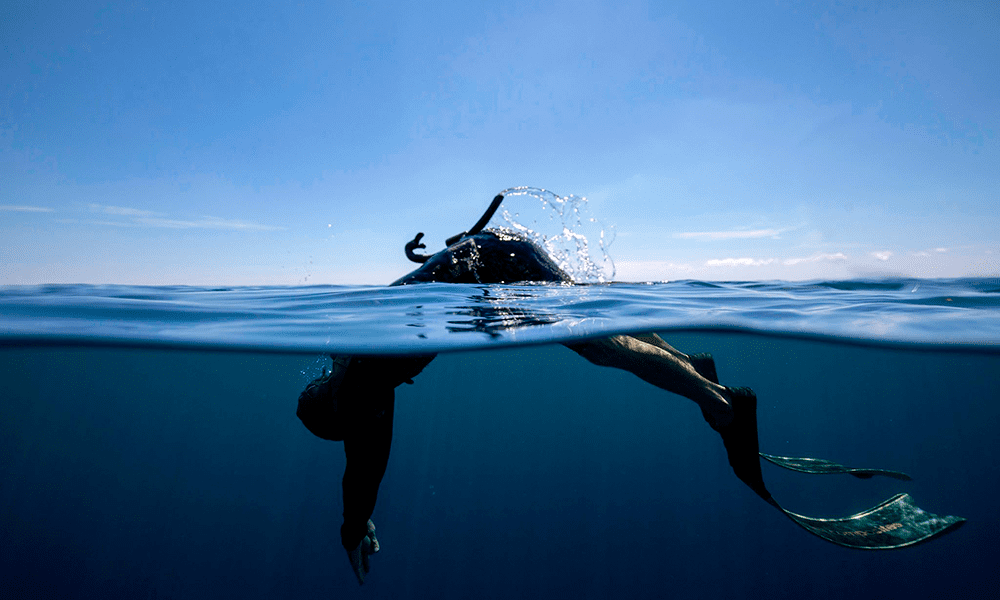
by Dean Laffan
It’s almost 1:00 am as my taxi from Denpasar airport bumps to a stop at my warung in the sleepy little town of Amed, in the North-East coast of Bali, Indonesia. A ‘warung’ is your typical Balinese locally owned accommodation, often with an attached restaurant, all run by the family. Amed is far from the picture of a typical Australian Balinese holiday which is usually centred around the tourist mecca party towns like Kuta or Canguu. Arriving in Amed is like visiting the United States bypassing LA and New York and heading straight to small-town USA; a Balinese version of Andy Griffith’s Mayberry.
The three-hour taxi ride follows a six-hour flight from my hometown of Melbourne, Australia. Everything I need for this trip to Bali is contained my single freediving gear bag. As a tech and cave diver, I still chuckle every time I pack my freediving bag. ‘Now let me see what do I need? Fins, booties, mask, snorkel, wetsuit, weight belt and … err what else? Well no that’s it! Cave diving this isn’t.
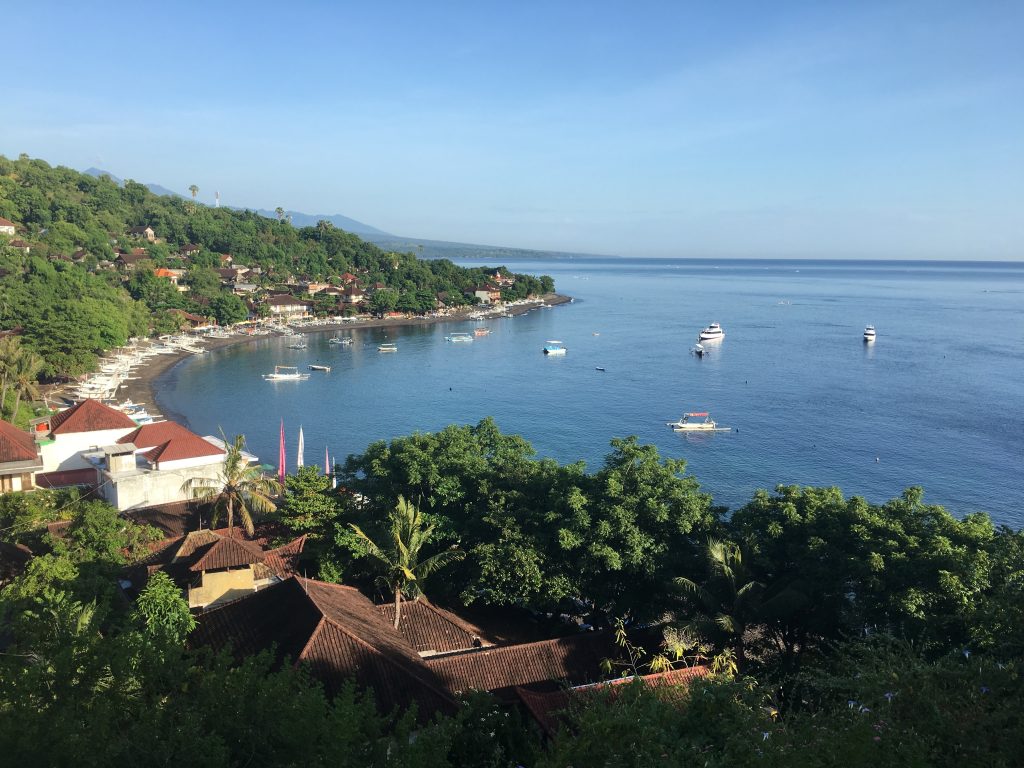
Jemaluk Bay and the town of Amed.
My room is ridiculously awesome. It is literally on the beach and the sliding glass doors face east out over the waters of Jemaluk Bay. I lay on the bed with my doors wide open, breathing in the warm Balinese air with the sounds of the waves washing gently onto the black volcanic sands of the beach.
As I fall asleep I’m still in disbelief I’m even here. Six weeks ago, I hadn’t even heard of Amed and did not know where it was. So what am I even doing here? Though I’ve been a tech diver, a cave diver, I’m here to learn freediving from the best instructors in the world for a training camp called “Deep Week.” There are 80 students and 40 accompanying instructors here in Amed and we are here because of one man, an internet phenomenon named Adam Stern.
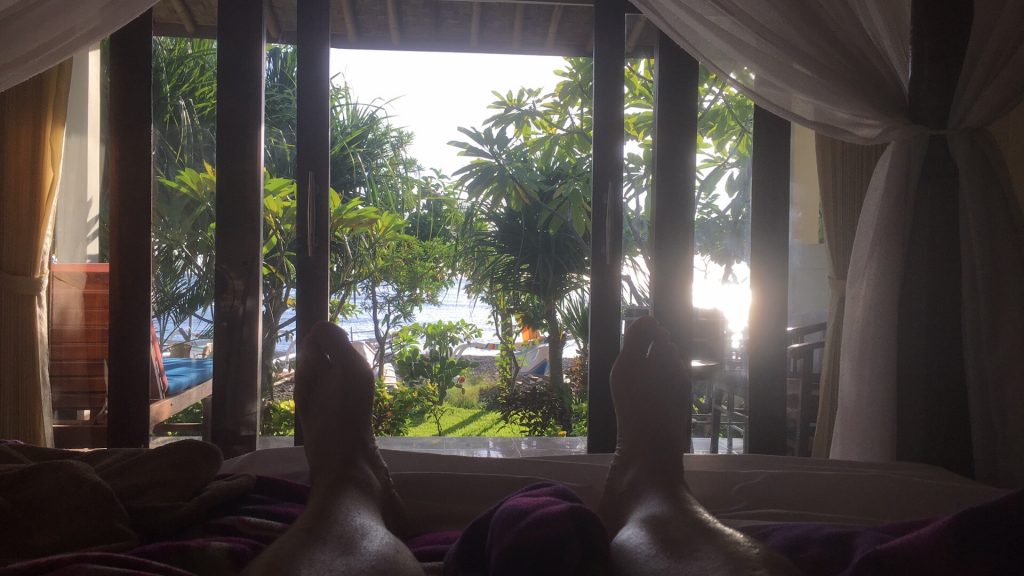
Lucky they don’t have a super tide in Amed, or I’d need to sleep with a twinset.
How To Make Deep Dives and Influence People
Adam is an Aussie from the New South Wales central coast, but he spends a lot of his time offshore in various tropical locales around the globe either running his freediving courses or competing in the various global freediving championships. He is the current Australian Champion in Constant Weight which means diving on a monofin up and down. He also scored a bronze medal at the World Championships in 2017 with a personal best (PB) dive to 106m/348ft. As he jokingly says in the introduction to some of his videos; “Hi, my name is Adam Stern. I hold my breath and dive really deep.” Funny and true. He’s seriously good.
In mid-2016, Adam began to upload various YouTube videos on freediving, sometimes of his own dives in competition, but he quickly started to build a library of useful ‘how-to’ videos for beginner freedivers. Tips like how to Frenzel equalise, how to ‘breathe up’ prior to diving, dry training tips etc.
When you watch him you instantly get his appeal. He is highly engaging, projecting endless levels of energy and fun, with a famously distinctive giggle. His laid-back delivery and loveable character combined with the highly insightful tips and hints he dispenses have made him a global superstar in the booming sport of freediving.
Let me throw a couple of numbers at you so you understand his astounding social media reach. When I first started to think about this article in mid-June, Adam had 70,000 YouTube subscribers, but now at the time of writing this piece only a month later, he has already grown to 80,000+ subscribers on YouTube, plus another staggering 167,000 followers on Instagram. But to be clear, his social media profile is not a result of him chasing ‘Likes’ but rather grown organically because he has ‘paid it forward’ and the community has responded.

By comparison, GUE’s own YouTube channel has just over 5,000 subscribers, TDI/SDI has just over 3,000 and PADI has 36,000. I’ll just let that sink in for a while. A kinda goofy, but highly likeable Aussie guy who makes his how-to videos in his backyard, shot and edited by his amazing wife Erin on the niche sport of freediving, has more than double the digital footprint of an industry behemoth and marketing powerhouse like PADI.
As another comparison, the current world championing in Free Immersion and Constant Weight (Monofin) the much loved and highly respected Alexey Molchanov has only 1,300 subscribers to his own YouTube channel. The landscape of elite freediving is a pretty small club, Adam and Alexey are great mates. Indeed Deep Week is run under the Molchanov School banner. So you would assume Adam must be doing something right and I’m here to tell you, he certainly is at that. Adam has done a brilliant job of building what Seth Godin calls ‘the tribe,’ a passionate group of followers who loves what he does and can’t get enough.

It Takes A Village
Over the next 24 hrs, I am slowly joined by my fellow students from literally all over the world. A few Americans but a veritable United Nations pile into Amed. Chinese, Filipino, Malaysian, Australian, New Zealanders, Middle Eastern, South African, French, Greek, Italian, Croatian, Belgian, you name a country and there’s probably one of them here. It’s my first time meeting a real live person from the home of Genghis Khan, Mongolia!
Before long we are all ready to begin the latest of Adam Stern’s famous Deep Week training camp. Oh and to further boggle your mind I am in the second Deep Week for this month, the previous one booked out within days, also with 80 students, forcing Adam to scramble and put in a second course. So, in less than a month, Adam has run 160 students through his week-long freediving program. A staggering number, especially considering he does four or five Deep Weeks per year. So annually the total numbers are around 400 students per annum.
One of Adam’s popular ideas has been to have a special guest instructor at each Deep Week. In the one just before my own course, it was the Croatian powerhouse of the pool, Goran Colak. In my week, it is the superb French National Champion Thibault Guignes. More on Thibault and his incredible teachings later. In November of this year, again in Amed, Adam will host the undeniable Weapon of Mass Destruction in global freediving, the incredible no-fins World Champion and record holder William Truebridge.
So at each Deep Week, it’s like learning Formula 1 from Lewis Hamilton, film directing from Ron Howard or dare I say, cave diving from Jarrod Jablonski! It’s mind-boggling that basic freedivers can access such world champions for training. And all the instructors work their butts off, both in the water and out. They are available at any time for in-depth questions on all aspects of freediving.
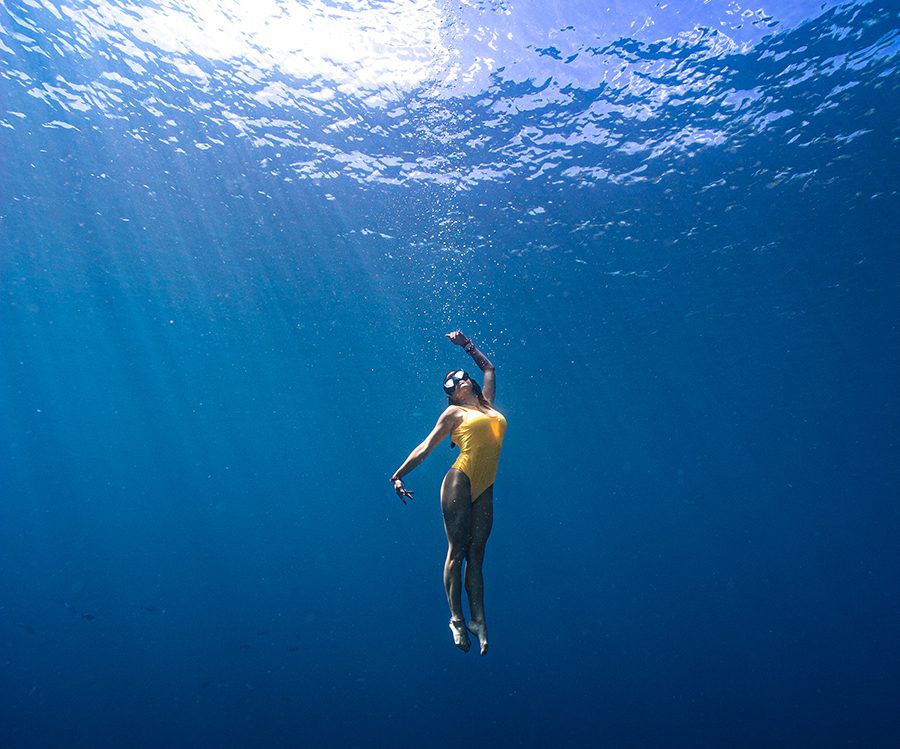
Hippy Hippy Shake
As a GUE tech and cave diver, I cannot emphasise strongly enough what a different vibe, freediving is to what I was used to in compressed gas diving. By its nature, freediving tends to draw a certain kind of character. I would guess that 80% of freedivers are practising either meditation or yoga. Yoga is highly beneficial to achieving the sort of relaxed state you need to attain to successfully free dive.
There is a definite ‘hippy’ vibe in the community, which are mostly younger people in their 20s and 30s, and in a major counterpoint to the tech diving community, easily half of the students are women. Furthermore, whilst you can skate a bit in terms of fitness when you have essentially limitless gas in big tanks or a rebreather, you cannot escape the need for good physical fitness in freediving. By nature, the sport self-selects to fit, healthy, motivated individuals. You simply cannot go very far, or deep if you are overweight, a smoker or are overly fond of beer.
Our time here during the course is split between two locations. On the beachfront is the freediving school and café called Apneista. All our shore dives begin here. Up the hill about 2km along the narrow blacktop, you come to the stunning facility called Blue Earth. Some students walk, but many rent a local motor scooter for US$4/day and use that to get around as many of the restaurants and other facilities are sprawled out along the coast road which runs for several kms.
Blue Earth is one of the most ridiculously beautiful and spectacular places you will ever see. Built in traditional Balinese fashion in a sprawl up and down the steep headland overlooking Jemaluk Bay. It features multiple levels of timber decks that jut out into space with sensational unobstructed views of the coastline and Mt. Agung. It is jaw-droppingly beautiful and constructed entirely of local timber.
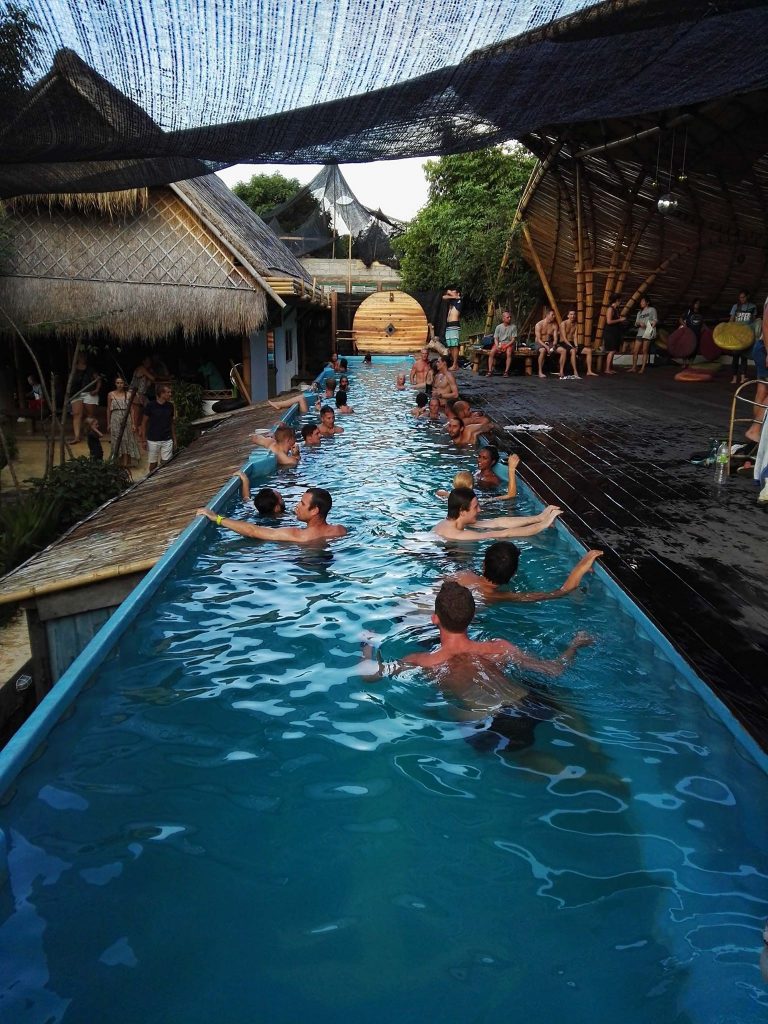
Along with two bars and a restaurant it also contains several large ‘shalas’ or yoga halls which function as our classrooms over the week. There are no chairs or tables all the shalas feature large piles of cushions and bedrolls that you pick up and sit on then put away at the end of class. They also have a brand spanking new 25m fiberglass lap pool in the middle of the facility used for training.
Oh lest you think this is some exclusive, expensive operation like a ‘Davos ‘for freedivers, the entire eight-day program which runs from 7:00 am to 7:00 pm over eight days is only US$695. Living expenses in Bali are crazy cheap, my amazing room on the beach was US$20/night. Typical tasty freshly prepared breakfast, lunch or dinner is about US$5. Local Bintang beer is US$1 So my entire trip including the course, flights, transfers, food, drink and incidentals was less than AU$2,500/ US$1,800.
A Day At Deep Week
On day one we all meet at Blue Earth in the biggest of the yoga shalas with an insanely spectacular view of Jemaluk Bay. Adam outlines how the week will go to the 120 odd people scattered all over the shala sitting on cushions on the floor in a lotus position. The vibe resembles a modern-day Woodstock for freediving. After the briefing is over we all have a massive group selfie and split off into each of our various student levels which in the Molchanov school are called ‘Waves’ and the first of the day’s concurrent theory sessions begin.
Each day starts with an optional yoga session which is very well attended. Then comes the morning theory sessions. By late morning students and instructors make their way down the hill to Apneista on the beach and get ready to dive. The first two-hour diving session starts at 10:00 am the second commencing at midday. There are about a dozen freediving buoys already setup and each buoy has a dedicated instructor.
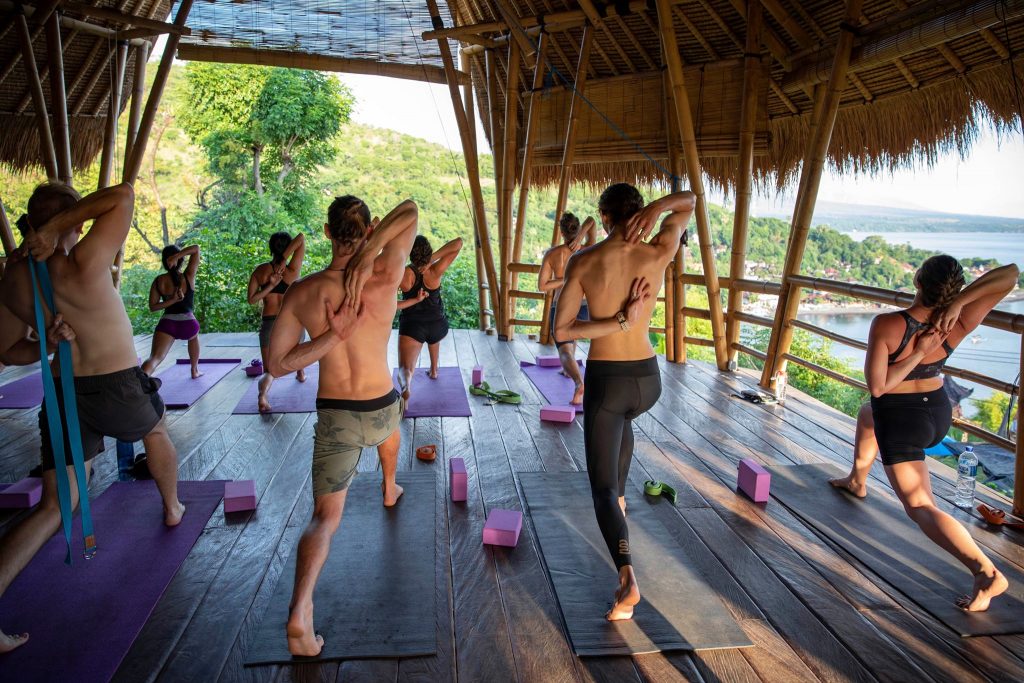
The student numbers per buoy are capped at three students. So you get two hours of solid instruction, feedback and correction over multiple dives each day and the instructors are without exception, friendly and highly supportive and very capable. Occasionally you will hear a cheer from a nearby buoy and a lot of celebratory splashing as someone has surfaced with a PB dive to depth.
Spare a thought won’t you, for Adam’s cadre of instructors. They pull consecutive two-hour shifts in the water without a break. Consider the work rate. In a three student group on a buoy one student is diving, one is breathing up preparing to dive, and one is recovering having just dived. Each diver leaves every five minutes or so, which is 12 dives per hour, so in a two-hour session, a student should get in at least four dives and eight over the two-hour training session. Pretty doable right?
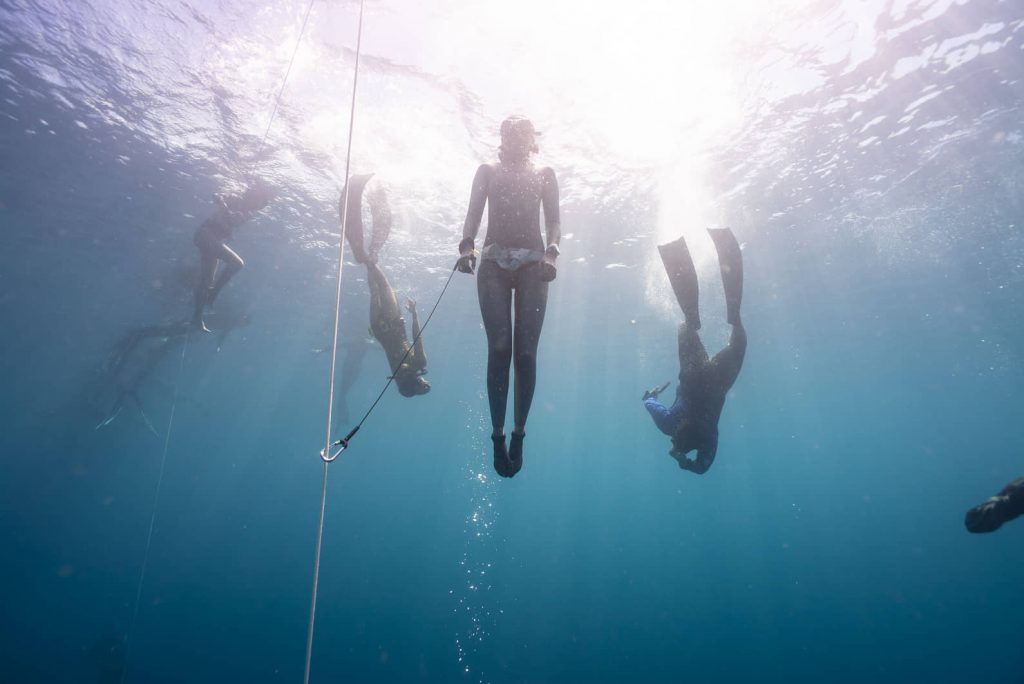
But the instructor has to safety every student diver. This entails the instructor diving down to meet the student at roughly one-third of their maximum depth. So in that four-hour block, the instructor would make 48 dives. At Wave 1 level these dives may only mean meeting the student at 6 or 8m. But at Wave 3 and 4 levels, the students are diving 40-50m so the safety is required to meet them at around 15-18m. Forty-plus dives to 15m in four hours, now that’s a workout. Oh, and it’s an 8-day course with a single rest day in the middle. On the final day, I spoke to instructor Julian De Hauteclocque Howe who had just returned from his final four-hour session. He commented that it had been, “a busy day.” A little prodding reveals he clocked 54 dives that day. Half of them ‘only’ to around 15m or so, but the other half ranging between 20m to 35m! No wonder the instructors are lean, mean diving machines!
By 3:30 pm we are back at Blue Earth for the afternoon theory sessions followed by an optional High-Intensity Training (HIT) session and finally a super relaxing guided meditation which is conducted by Adam’s amazing mother Andrea. This relaxing session is timed to conclude in the gloom of twilight and is the perfect way to end the day on a cloud of relaxed bliss.
By the early evening, people clump together in various social groups and either stay at Blue Earth for their excellent food and astonishing views or head downhill once more into town to one of the myriad warung restaurants that line the coastal road for several kilometres. Mercifully there is not even a single rowdy bar in Amed and by about 9:00 pm most of the warung restaurants are closed, lights are off and everyone has retired for the night.
You might suspect that the town comes alive at first light, but you’d be wrong. Certainly, just before first light the fisherman push off the beach in their outrigger boats, but by and large it’s a slow start to the day. You can’t even really get breakfast anywhere until 8:00 am. So if you need your 6:00 am coffee to get started, forget about it! This is ‘island time’ baby!
Hanging With Thibault
The next seven days pass in a blissful procession of deeply interesting theory sessions discussing topics such as advanced Frenzel equalisation, mouth fill technique for deeper diving, dryland training for freediving, stretching your chest and intercostal muscles for increased lung capacity. At this point, I must say that the classes by Thibault Guignes were incredible. Whilst the sport of freediving is in its infancy of education and some instructors can be a bit laissez faire, Thibault by nature is super organised and highly prepared. He has his own school called Freediving HQ Philippines in Panglao, the Philippines where he has ten instructors on staff and is booked out for months in advance at a time, I can see why.
I don’t have time here to recount all of his amazing lessons, but let me mention just two astounding moments. Part of his dry training exercises features a lot of stretching. The flexibility is crucial for staying relaxed in freediving, so part of his routine involves lying face down with a large plastic drink bottle between his sternum and the floor. Over time this and other stretching has loosened the ligaments that hold his rib cage together and allow him to greatly expand the maximum capacity of his lungs. Now that’s commitment!
Although slightly built, (he was previously an avid competitor in triathlons), he takes off his T-shirt to demonstrate some aspects of physiology and at one point takes a full breath. Jaws drop all round as we see just how much flexibility there is in his chest and how his entire thorax now looks like a bodybuilder! To further boggle our minds, he puts his palms against the sides of his chest and pushes in hard, bowing and compressing his entire chest and ribs. Gasps ripple around the room. Its heady stuff.
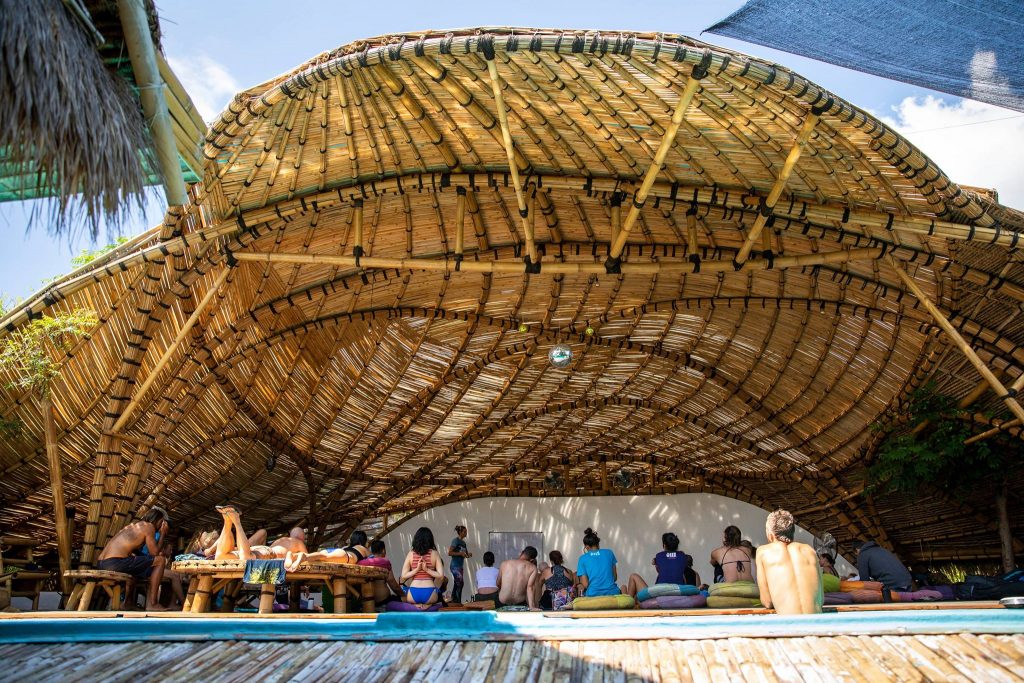
Now, before I talk about Thibault’s deep hangs, I would be remiss not to highlight some issues around safety. Thibault is a world-class freediver with multiple dives over 100m. He is an elite freediver. He was not recommending this for any of us students, but he was being very open in sharing what he does in training for his record dives His regime is meticulously constructed so he never has to push hard into the dangerous hypoxic territory.
This technique that I’m about to describe is a way to build-up to the actual dive to depth before he physically goes there. His safety divers who meet him on his ascent, are themselves world-class freedivers. All his dives are calculated precisely for travel time, he is very consistent in his travel times and he does not hesitate to turn the dive at any time if he does not feel right. Ok, so on we go.
He showed some screenshots off his dive computer (pictured below) The profile shows a precise downslope and a symmetrical matching upslope back the surface and in between, a dead flat bottom time. He explains that as he is training to go deeper than his current PB, he can ‘simulate’ that to some extent without physically going there. It’s a peculiarity that freedivers no matter what level from beginner to world record holders all travel both up and down in the water column at about the same speed which is around 1m/second.
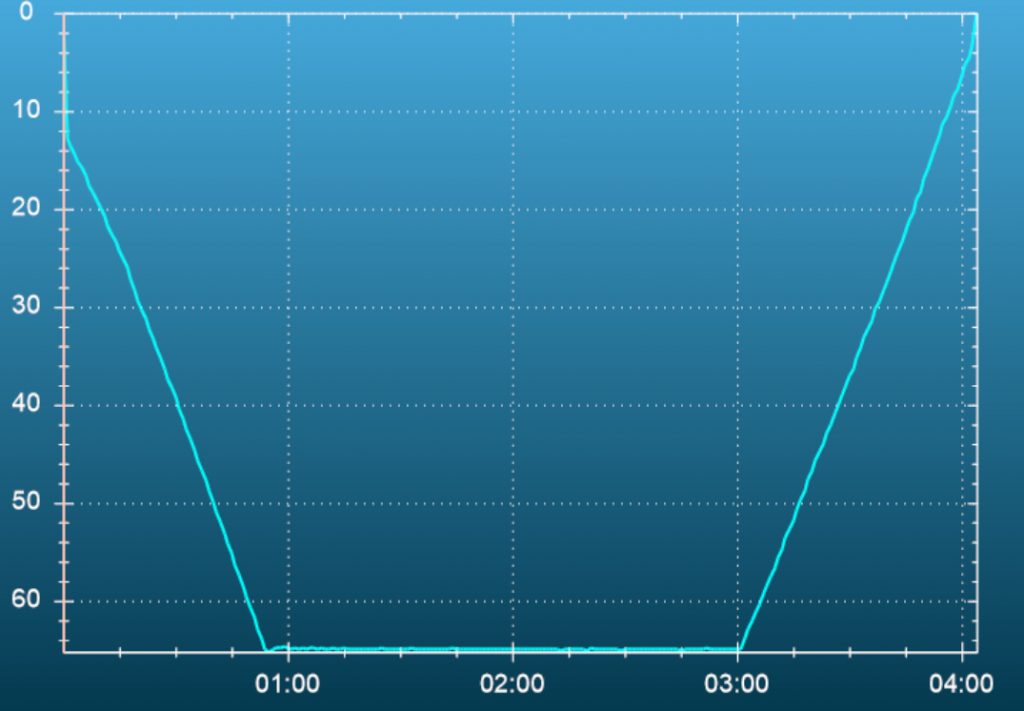
The profile shows Thibault diving to 65m and then hanging on the line to simulate the travel to 120m and back 65m. Yes, you just got those quick maths right! Not only does the man dive down to 65m on a single breath, he then just hangs at depth for two minutes, before starting his ascent! Drawing further wide eyes and slack jaws was another of his dives to 90m with a lazy hang of 45 seconds before returning to the surface Talk about gobsmacked. This is just one example of the level of instructor Adam has been able to bring to Deep Week and why they are such an ongoing success, booking out in record time, every time.
Throughout the week there are also dedicated workshops on the different freediving disciplines. Let me break down the various acronyms for you.
CWT – Constant Weight. This means you leave the surface with the same weight you return with (no ballast or sled) at beginner level this is done with standard long-bladed freediving bi-fins, in advanced cases you may choose to use a monofin which delivers more power and greater speed with better efficiency than separate fins.
FIM – Free Immersion. In this case, you don’t need fins as you pull yourself down the line hand over hand until you reach negative buoyancy and begin to freefall, on the return you also pull up the line had over hand back to surface. You cannot mix FIM and CWT, it’s one or the other, or you are disqualified.
CNF – Constant Weight No Fins. As the name implies bare feet and hands. This is often performed with no mask or goggles, just a nose clip clamped over your nostrils allowing you to clear your ears hands-free, as your hands are needed to perform the regular breast stroke like hand action to propel you up and down in the water column.
VWT – Variable Weight. Divers ride to depth on a metal sled attached to the line and swim back up under their own power. This is a modern version of the classical Greek tradition where a rock was used by sponge fisherman to get quickly to depth. It is still practiced today, called ‘Skandalopetra’
NLT – No Limits. Divers ride a sled down like VWT, but ascend using a lift bag attached to their wrist via a lanyard. The rapid ascent rate allows the deepest attainment of depth.
It is worth a small detour here to mention that the current world record for NLT is currently held by Austrian Herbert Nitsch, at a mind-boggling 214m/702ft. If that’s not enough for you Herbert also ‘completed’ a deeper dive to the unbelievable depth of 253m/830ft in 2012, but blacked out on ascent and almost immediately after surfacing suffered a severe cerebral DCS which initially left him in a wheelchair but after months of therapy he made a substantial, though not complete recovery. That dive ended his competitive career, though he still freedives today for his own pleasure.
Freediving Safety
When diving deeper than 20m it is a usual safe practice to wear a tether to the downline. This is a 1.2m plastic-wrapped steel cable with a shark clip on the line end and a Velcro wrist strap at the diver end. The shark clip is oversized so it falls freely on the line. In any emergency where the line ever became an entanglement hazard, the diver simply rips off the wrist strap and ascends the line, though in practice this is very rare.
The other use for the leash is a little more serious. The downline terminates at a round aluminium plate about 0.3m in diameter. The shark clip cannot come off the end of the line. In an emergency where the diver has blacked out at depth, it is quite a speedy process for the surface safety to untie the down line at the buoy end and quickly haul the plate up and in so doing, recover the unconscious diver to the surface where resuscitation is usually successful.
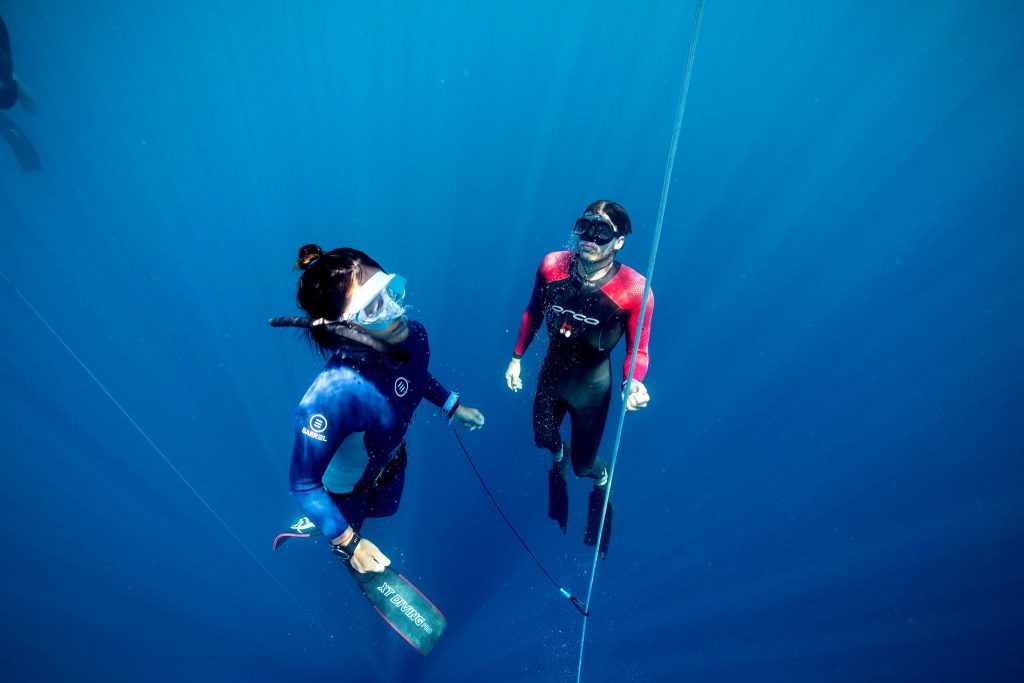
According to the 99% rule of thumb, 90% of blackouts happen on the surface, 9% happen between 5m and the surface, and the remainder occurs below 5m. The danger is not the blackout itself, but the subsequent aspiration of water and possible drowning. To make things worse, they generally occur without no warning. That’s why breath-hold safety divers, in the case, the instructors, meet students at one-third of their max depth on the ascent. In the event of a blackout, the safety diver protects the student’s airway by closing the mouth and nose and brings the diver to the surface for resuscitation.
Whilst breath-hold deaths by spear fisherman, aka “spearos,” are not uncommon (over 50 per year in the US vs about 20 for tech divers), deaths in the world or national competitions are almost unheard of. Only two deaths have been recorded in the last decade. One was in 2017 when the Irish Stephen Keenan was rescuing Italian female champion Alessia Zecchini from 50m at Dahab’s Blue Hole. He successfully handed her off to other rescuing safety divers but in doing so, he suffered a shallow water blackout and could not be revived. This was the first death of safety diver in freediving history.
The only other death in the competition was in 2013 when American diver Nick Mevoli was competing at the Vertical Blue competition in the Bahamas. He surfaced from his 72m no fins dive (CNF), but soon after collapsed, stopped breathing and could not be revived. An autopsy later established he had suffered lung barotrauma at depth causing bleeding into the lungs. Further investigation revealed had recently suffered similar but less serious squeezes and this led to medical recommendations that freedivers suffering lung squeezes leave a much longer recovery period before recommencing deep diving.
Ahead of arriving in Bali you receive access to the online Molchanov website which includes a community board, a series of WoWs (Workout of the Week) and a detailed PDF manual covering the many aspects of the course including diving technique, history, physiology and safety.
To meet my Wave 2 criteria I successfully completed the following criteria in Amed:
2:30+ min Static Breath Hold
55m+ Dynamic With Fins
35m+ Dynamic No Fins
24 – 30m CWT and FIM in the open water
15m Constant Weight No Fins
Demonstrate Free fall technique
Moving Meditation
As I progressed through Deep Week, I’m struck by what a contrast freediving is to tech and cave diving. So much about what we learn in GUE is dealing with ‘stuff’ and situations and a lot of that is to do with gear. Riding your scooter, rotating your stages, making the gas switch, tying to arrows and cookies, communicating with your team. For sure it’s all great fun and very rewarding when it all comes together. But compared to freediving, it’s very much ‘externally’ focused.
You don’t need to consciously deal with what is going on inside your own body, it’s autonomous. You, you breathe in and out, it’s subconscious, your active mind is pinging out like a radar, where is buddy? where are we in the cave? how is my gas? how are my bottles riding?
Freediving is the exact opposite. Once you are tethered to the line and preparing to dive, there is almost nothing outside of your skin that you need to be aware of or care about. It’s a very singular pursuit, it’s only your own performance that you can affect and control. In tech diving, we need to deal with various degrees of equipment, in freediving you are the equipment. You get there and back based on your own body and mind. It’s not better or worse, it’s just different.
As a long-time tech diver, I was surprised at how much I enjoyed the change-up from compressed gas to breath-hold diving. I have in previous conversations with non-divers described cave diving as a form of ‘moving meditation’ the art of moving carefully, slowly, gently through a delicate environment.
But freediving takes that moving mediation analogy to a whole different level. Yes, you need a base level of cardiovascular fitness, but it’s as much about training your mind as it is your body. The ability to completely relax in preparation for the dive, to remain calm and focused as the C02 driven contractions start to occur, keeping good form in the water and applying different ear clearing techniques as you descend deeper and deeper. It has been said that:
“The scuba diver dives to look around, the free-diver dives to look within.”
The thought has occurred to me that we as freedivers use our travel through the water column and it’s change in pressure on our body, to simultaneously take a journey within the mind. It’s a journey only possible by diving to depth on a single breath and feeling the big ‘hug’ of the pressure when you reach residual lung volume. It is both humbling and inspiring and you surface in elation, wanting to go again and again. In freediving, I have truly found a confluence of mind, body and spirit.
Home on Blue Water Planet
Deep Week concludes with an absolutely wild party at Blue Earth. Guys and girls who have been on their best behaviour, cut loose and it’s booze and dancing till late in the night. It’s after midnight when I make my way back to my warung. It’s quiet, dark as I walk along the narrow road and there is not a soul to be seen.
As I approach my room right next to the beach, I’m struck by a random thought. I walk the short distance to the water and peel off my shirt and shorts and naked as the day I was born I wade into the warm 32C degree water of Jemaluk Bay. I rock gently in the barely-there swells and float face up gazing into the sky … which is spectacular beyond belief.
There is zero light pollution in this far-flung country town so the entire sky is lit up with stars, bright and dense from horizon to horizon like a photograph from the Hubble. I can see white stars and also hints of other stars in red and blue light.
I spot the Southern Cross, though it’s not quite where it should be to my Melbourne born eyes, some constellations are recognisable, a few more I don’t recognise. I can see the misty swathe of galaxies I’ve never even seen before and I’m filled with peace and wonder.
I float there, my face kissed by the cool starlight of the cosmos, my body embraced by the warm ocean water and I’m reminded of something the British astrophysicist Brian Cox pointed out in his excellent TV series ‘Wonders of the Universe.’ That is: if you took every single grain of sand from every beach in the entire world, and counted them out, they would not even begin to equal the number of suns in our universe, never mind the planets that revolve around them.
Floating on my back with the sand grains of Bali beneath me and the endless stars of the universe above, I am sandwiched between our own blue water planet and the endless majesty of the universe. I ponder the irony of gazing into outer space, while floating in inner space. I feel at once incredibly small, yet also connected to the universe and feel lucky that we live on this beautiful blue orb, the only water planet in our solar system and I wonder if my life will ever be the same again.
I certainly hope not.
Contributing photographers: Adam Stern, Trista Fontana, Bridget Ferguson, Dean Laffan
Dive Deeper:
Technical (Mixed Gas) Freediving Is Here: Are Breath-hold Divers Ready To Mix It Up? by Michael Menduno
Appendix
To give you an idea of what human beings can accomplish, here are the current world records for each freediving discipline.
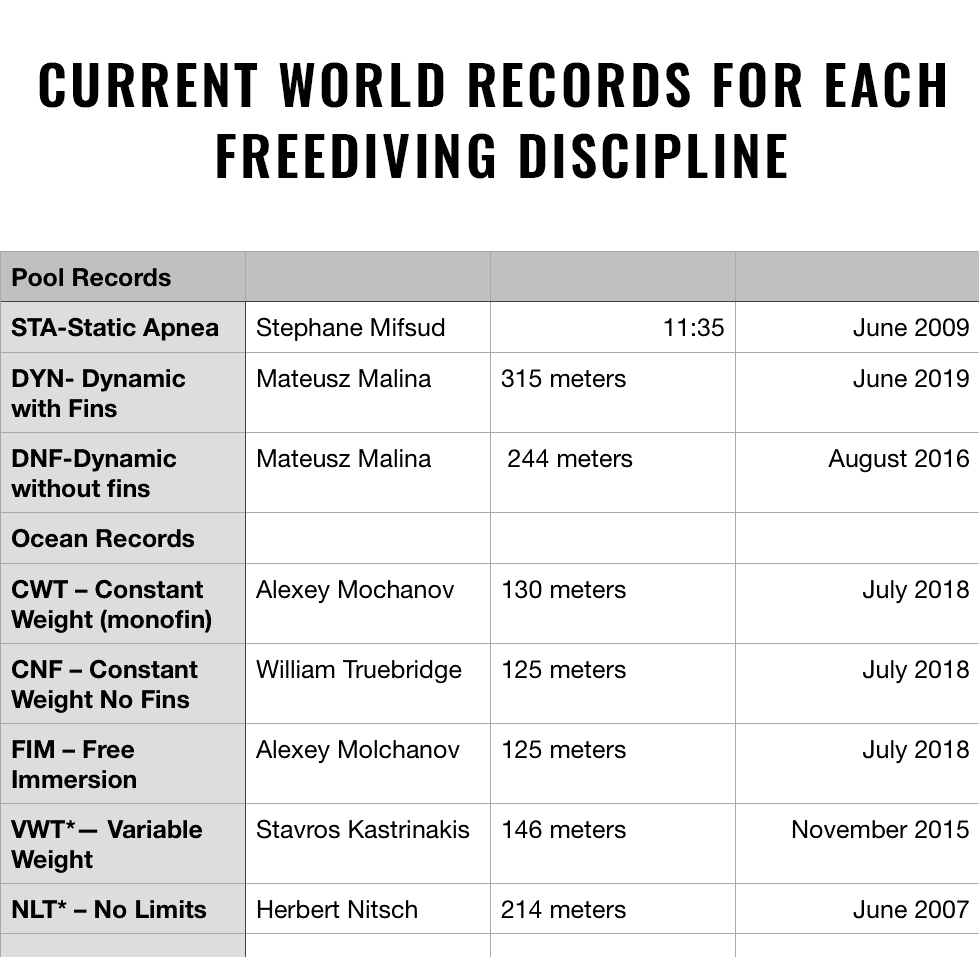
* For clarification Variable Weight means the diver can use weight to get to the target depth, usually a sled or similar device and returns to the surface via a combination of finning and pulling up the line by hand. No Limits uses the same sled device, but divers ascend by deploying a small lift bag secured to their wrist for a more rapid ascent and less effort, allowing a much deeper target depth.
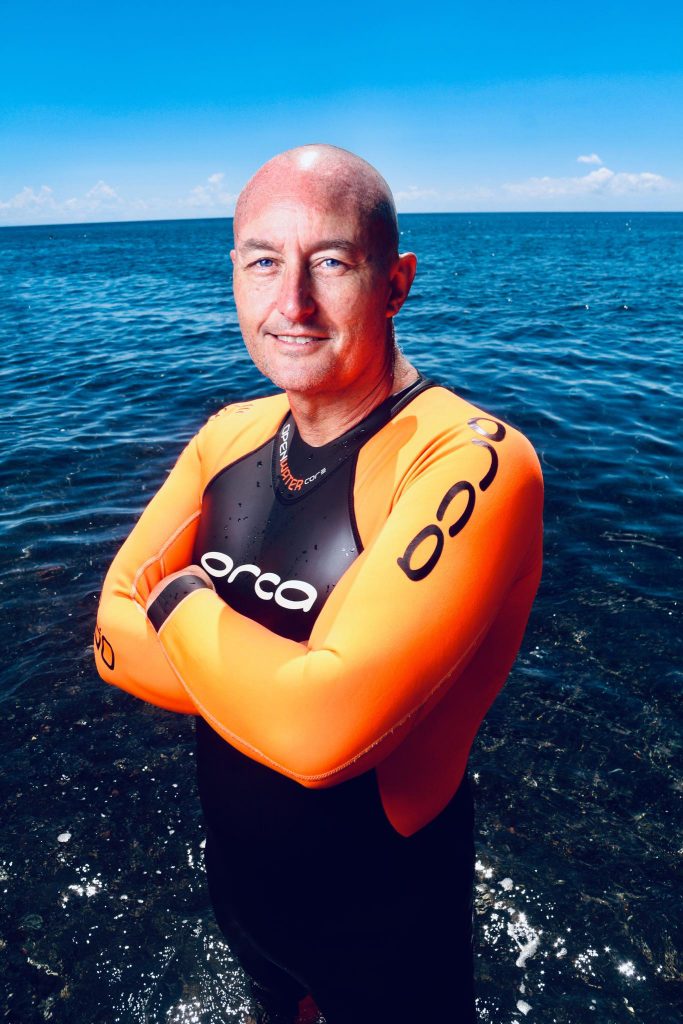
Dean Laffan: Fuelled by a boyhood fascination with the books and TV shows of Australian diving pioneers like Ron and Valerie Taylor, Neville Coleman and Ben Cropp, Dean took a scuba course as soon as he left school and has never left the water since. After discovering GUE in 2001 he was instantly sure he had found his ‘tribe’. He was one of the organisers of the very first GUE class in Australia run by Jarrod Jablonski.
After many technical and cave dives including some ground-breaking cave diving expeditions to the Nullabor, it was only in 2018 that he finally fulfilled a long-held ambition to take up freediving, which has now become an obsession.
Dean lives in Melbourne Australia with his ever-patient wife and three beautiful children and remains eternally grateful to be born at a time in history when we can still find new frontiers to satisfy our endless curiosity of discovery.



















